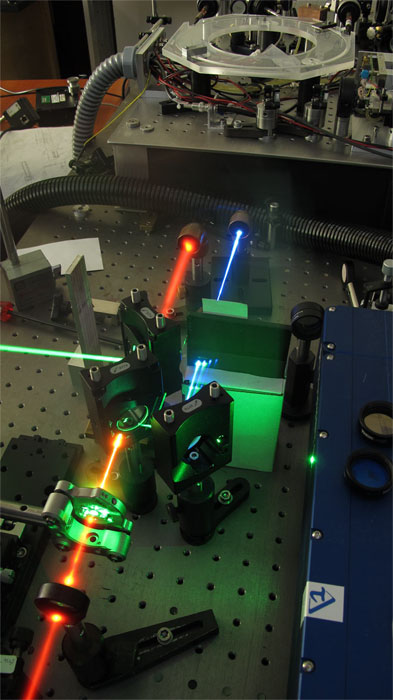A miniature tripler for generating femtosecond pulses in the UV has demonstrated three times higher efficiency than previously used devices, in a design that is tiny enough to fit on a fingertip. The increase in efficiency is related to the global optimization of the frequency conversion process from IR to UV.
Although laser technology has advanced to cover a greater number of spectral regions, the UV band around
300 nm is still not easy to access, especially if short pulse durations and/or high intensities are required. Often, UV pulses are generated via nonlinear processes that allow NIR laser pulses to be converted to UV. Frequency converters, which enable scientists to tweak different device parameters typically one at a time, have resulted in conversion efficiencies of only around 10 percent.

Miniature tripler (in the silver mirror mount) generates intense blue, and ultraviolet laser pulses form focused beam of IR light. Courtesy of UW Physics, Radoslaw Chrapkiewicz.
Researchers at the University of Warsaw have demonstrated a miniature tripler with conversion efficiency exceeding 30 percent, producing 246-fs UV pulses via cascaded second order processes within a single laser beam focus. The design of this highly efficient, ultra compact frequency converter was made possible by using full 3D modeling of the propagation of tightly focused, broadband light fields in nonlinear and birefringent media.
The researchers developed an open source simulation package, called Hussar, that will enable even inexperienced users to build accurate 3D simulations of multiple pulse propagation and interaction.
“Once we defined the input pulse parameters, such as energy, duration and spatial beam profile, we essentially started searching for the best design over a large space of parameters: the nonlinear crystal thicknesses, the beam size, the beam waist position, etc.,” said software developer Tomasz Kardas. “To our surprise, once we found these optimum values, built the device and measured its performance, the output UV pulses were exactly as simulated. This kind of quantitative agreement between what one gets on the screen and then measures in the lab is rather uncommon in nonlinear optics.”
Increasing the tripling process efficiency by a factor of three, to above 30 percent, was just the first step. The researchers also aimed at miniaturization of the device. Rather than using multiple components mounted on a laboratory table, their tripler is a tiny block of crystals stacked together.
“In fact, the one-inch metal holder that keeps all the elements together is the biggest part of the whole setup,” said Pawel Wnuk, who had a leading role in the device characterization experiments. “As a result, the tripler prototype has an overall volume around 1000 times smaller than traditional, previously used designs.”
Watch a movie showing the three laser pulses propagating in the linear and nonlinear crystals of the miniature tripler (3D simulation results).
The research was published in Scientific Reports (doi:10.1038/srep42889).